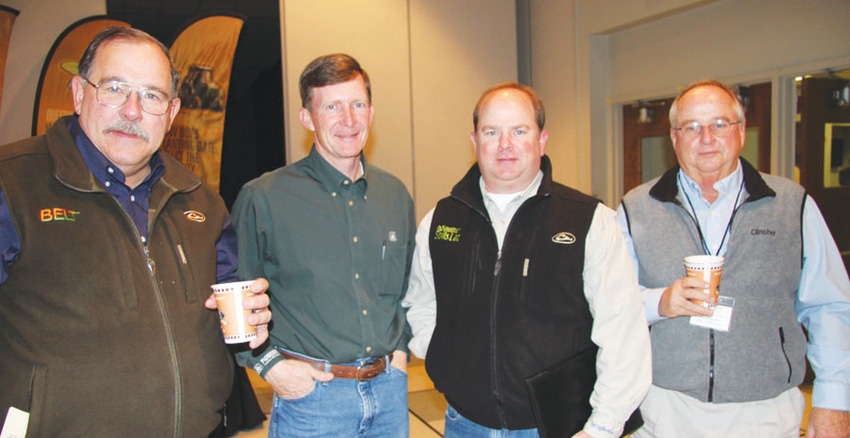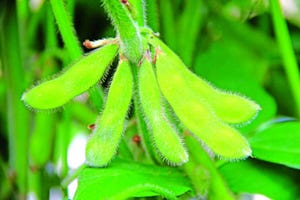
"We all know it’s yield that pays the bills — and if you don’t give the crop the nutrients it needs, you’re not going to produce maximum yields,” says Bobby Golden, assistant research professor at the Delta Extension and Research Center, Stoneville, Miss. He discussed the need for proper fertility in a soybean/corn rotation program at the annual meeting of the Mississippi Agricultural Consultants Association.

With more Mississippi producers following a corn/soybean rotation, scrimping on crop nutrients can mean leaving money on the table at harvest time.
“Producers tell me, ‘I can’t make that fertilizer application because it’s going to cost me an extra $25 per acre,’” says Bobby Golden, assistant research professor at the Delta Extension and Research Center, Stoneville, Miss.

IT'S IMPORTANT to maintain fertility in a soybean/corn rotation.
“But we all know it’s yield that pays the bills — and if you don’t give the crop the gas it needs to run, you’re not going to produce maximum yields,” he said at the annual meeting of the Mississippi Agricultural Consultants Association.
“I know fertilizer is expensive. But, we’re paying high costs for land, for seed, and other production inputs. We gripe about it, but we pay. Why are we so reluctant to do it with our fertility?”
It’s important to maintain soil fertility, Golden says. “You don’t want to draw it down because it will cost you a vast amount more money to raise soil test levels than it will to maintain the current level in the field all along.”
“Corn removes more phosphate than soybeans, and soybeans remove more potash than corn — but when you put them together in a one-on-one rotation, you’re going to have somewhere between 180 and 200 units of each coming off the field in the grain cart, based on 200 bushel corn and a 60 bushel soybean yields.”
Soybeans also remove a lot of potassium from the soil, Golden says, and “there is a very tight correlation between potassium and soybean yield. For typical 60 bushel soybeans, we’re removing around 80 pounds of K20. If we’re not putting back 80 pounds, we have the potential for drawing down our soil test numbers.”
Early stage studies in Mississippi indicate a response to potash in soybeans up to about 150 parts per million soil test K, he says. “Data are limited on this, but we hope our work can nail this down a bit better, so we’ll be able to offer more precise recommendations.
“In one site we looked at in the Delta, where soil had been mined of nutrients, they were missing 10 bushels of soybean yield because they had been omitting potash and phosphorous over a period of several years.”
In the Midwest, Golden says, there is a well-established correlation between potassium and corn yield, “but we have very little work on this in the Mid-South. Do Iowa and Nebraska results hold true in the Mid-South? We feel they do, but more research is needed to establish values here. We think soil test K can predict yield in the Mid-South, just as it does in Iowa, but we need to establish those values, and we got a good start with work we did in 2012.”
On two distinctly different sites in the Delta, Golden says, yields were improved significantly by applying 80 units of K20.
“On a very sandy site, we saw a large yield increase, 75 bushels, over the untreated control. On the heavier soil site, we still got a 27 bushel increase. In both cases, a lot of money was being left on the table by not providing adequate fertility to the corn crop.”
Corn needs zinc for top yield
Zinc is also important to maximize corn yield, Golden says, and producers and consultants should be watchful for signs of zinc deficiency.
“If I told you I could get you 10 bushels more per acre just by applying zinc, I think you would take it. Even with marginal zinc deficiency, it generally pays to apply zinc. In such cases, we routinely found that an over-the-top application could give us on average 10 bushels per acre more.

ZINC is a key nutrient in obtaining maximum corn yields.
“At a Bolivar County site, on old rice soil with a pH over 8.0, corn yields in the untreated check were very good — a little over 200 bushels. But where we applied 5 pounds to 7 pounds of zinc, we got an additional 29 bushels. Even though we were already getting a high yield, we were leaving money on the table by not applying zinc.
“On a site at the experiment station, we were cutting 190 bushel corn in the control plot, but where we applied zinc we increased yield by more than 16 bushels.”
Light-textured, low organic matter soils with high pH are where zinc deficiencies are seen most, Golden says, particularly if the field hasn’t had a history of zinc fertilization. “Old, well-watered cotton soils are where we have been observing these problems. With cotton acres declining and a lot of those soils going into corn, that’s where we should look for zinc deficiency.
“Typical zinc deficiency symptoms show up early season, around the V-2 or V-3 growth stage, when corn starts getting stressed in cold, wet soils.
“For years, the best method to alleviate this problem was granular fertilizer, zinc sulfate applied at 10 pounds actual Zn per acre. Producers often object to the cost. But I tell them, ‘It costs money to build up your soil test — you’re investing for the future.’”
When using these granular sources, Golden says, rate should be adjusted based on the water solubility of the zinc source. “With any zinc source, you want the highest water solubility you can get. When you need zinc, you need it right then — not six months down the road. If it has relatively low water solubility, it’s going to take time to break down for the zinc to become available.”
Fields should be scouted closely at the V-3 to V-4 growth stages to detect zinc deficiency, he says. “If you miss the deficiency signs, then put out your sidedress application and the plants start growing vigorously, you may never know the deficiency was there. But you’ll be hurt on yield at the end of the season. So scout carefully during those early growth stages.”
Many growers have reported leaf burn after spraying over the top with citrate chelated zinc products, Golden says. “In some cases, six days after application we saw up to 65 percent leaf burn. So just be aware, if you use a citrate chelated product, you’re probably going to have some foliage injury.”
But he says, “Even though there was very significant leaf burn from these products, preliminary results suggest it didn’t adversely affect yield.”
The takeaway message for producers on a corn/soybean rotation, Golden says: Soil sample on a routine basis and follow recommendations to keep soil productivity high.
About the Author(s)
You May Also Like



